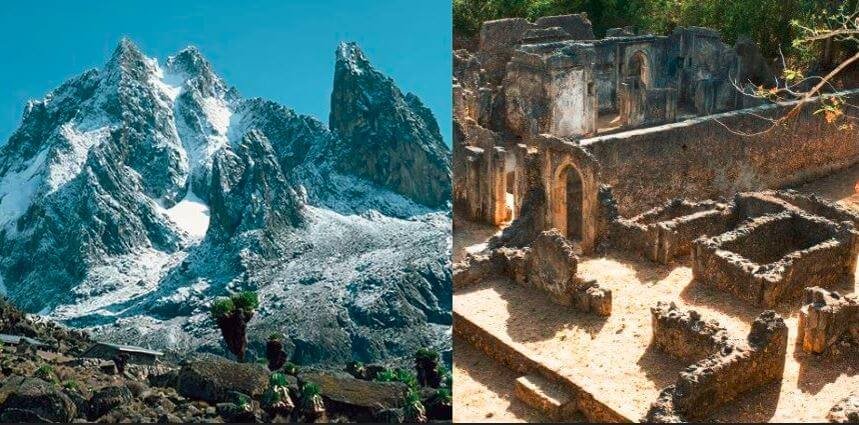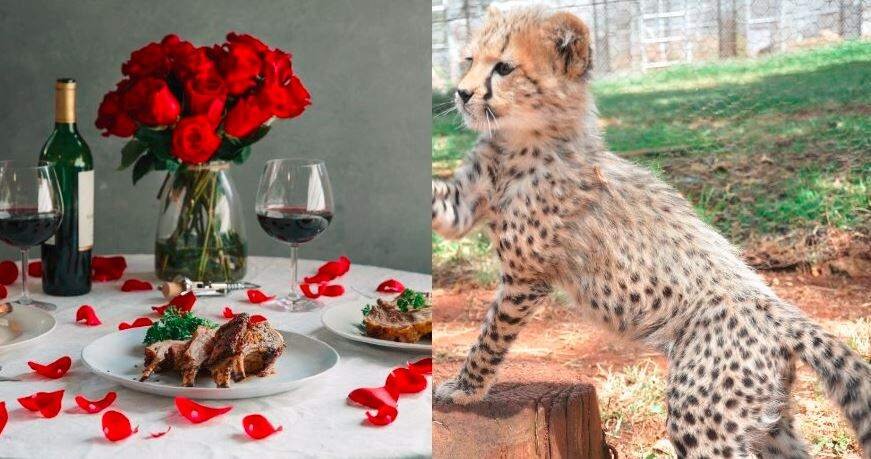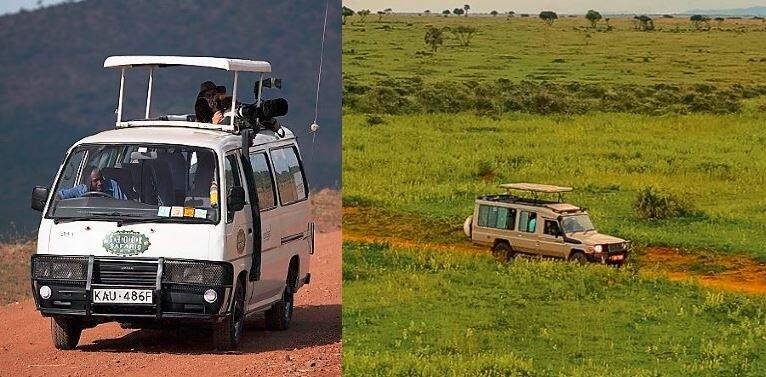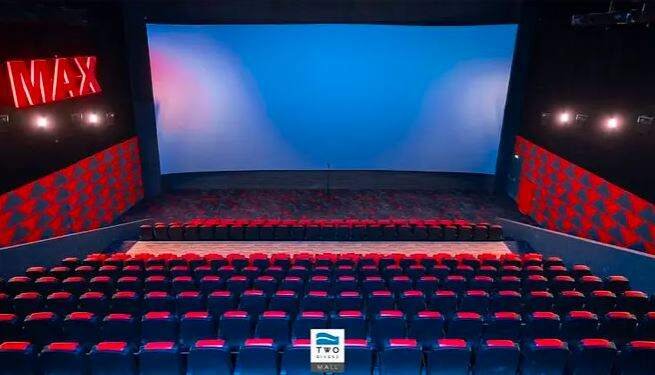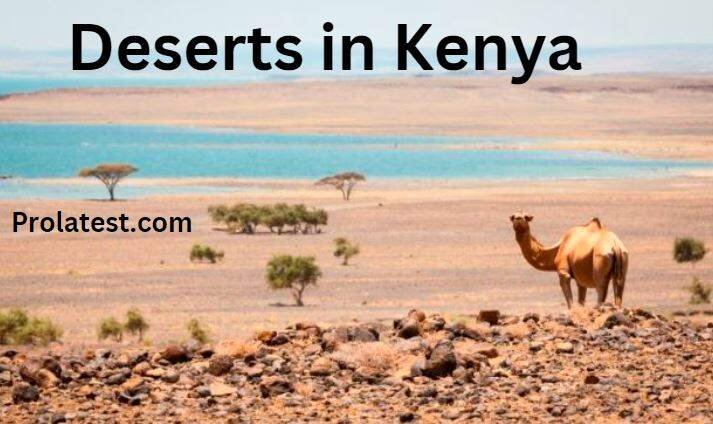Are you tired of the same old travel destinations in Kenya? Do you crave an adventure that combines rich history, breathtaking landscapes, and cultural wonders? If so, you need to visit some of the most famous landmarks in Kenya.
Visit the most renowned landmarks in Kenya will satiate your wanderlust and leave you with unforgettable memories. So, brace yourself as we explore the most famous landmarks in Kenya for your next trip. Keep reading!
1. Mount Kenya

Mt. Kenya, a mammoth extinct volcano near the equator line, is the most unique landmark in Kenya. Mount Kenya, a UNESCO World Heritage Site, is about 200 kilometers north of Nairobi City. It competes only with Mt.Kilimanjaro (in Tanzania), as it is the second-highest peak in Africa.
Thus, most local and foreign tourists come to hike and climb Mt. Kenya. Mt. Kenya has three peaks: Batian, Nelion, and Point Lenana. The highest peak Batian rises 5,199 meters above sea level. Nelion and Point Lenana are 5,188m and 4,985m respectively.
Anyone who is medically fit to climb a mountain can at least get to Point Lenana. Mt. Kenya has three access routes:
- Naromoru Route
- Chogoria Route
- Sirimon Route
Mountaineers no longer use the Timau, Burguret, Meru, and Kamweti routes. Ensure you climb Mt. Kenya with a KWS (Kenya Wildlife Service) certified tour guide to be safe. Mount Kenya National Park and National Reserve is 2,800 square kilometers. It is home to the following animals:
- Elephants
- Buffalos
- Rock hyrax
- Birds
- Bushbucks
- Zebras
- Elands
- Hyenas
- Colobus monkeys
- Waterbucks
- Guegnons
- Leopard
- Rhino
- Giant forest hog
- Bongo
Find Out: Religious Retreat Centers In Nakuru City
The wildlife shelter has more than 800 known plant species. About eighty-one of these are hard to find elsewhere. Come to Mt. Kenya during January, February, and August to enjoy safe hiking, mountain climbing, and camping.
2. Maasai Mara National Reserve

Maasai Mara or Masai Mara National Reserve (1,510 square kilometers) is the most famous wildlife park in South-west Kenya. It is an extension of the Serengeti National Park, the most famous animal shelter in Tanzania.
Masai Mara gets its popularity from the annual Wildebeest Migration. The annual exodus begins in Serengeti and ends in Masai Mara. Countless wildebeests and some zebras must jump into the crocodile-infested Mara River and cross over to the Kenyan side.
The cross-over is quite a spectacle for Masai Mara tourists. Maasai Mara has over ninety-five mammals and more than five hundred and seventy bird species. Some of the
animals you can view during game drives are:
- Wildebeests
- Zebras
- Antelopes
- Lions
- Buffalos
- Cheetahs
- Hyenas
- Birds
- Baboons
- Leopards
- Rhinos
Masai Mara has many tented camps and major tourist resorts for your accommodation. The best time to catch the mass wildebeest migration in Kenya is between July and October.
3. Diani Beach

Diani Beach has stunning beauty and several tourist attractions. It is on the South Coast region and about one hour drive from Mombasa City. Diani covers over ten miles of beach sand and offers the clearest views of the Indian Ocean.
Suitable to visit all through the year, Diani Beach is an all-encompassing tourist landmark. This is why it is on our list of the most famous landmarks in Kenya. Diani offers various beach activities: swimming, dolphin viewing, snorkeling, diving, kite flying, and windsurfing.
Here is an outline of other things to do in Diani Beach:
- Visit the Bora Bora Wildlife Park
- Tour the Colobus Conservation
- Follow the nature trail in Kaya Sacred Forest
- Play golf at Leisure Lodge Golf Club
- Head to the Wasini Island in a yacht
- Taste the local Swahili dishes and learn something from the
- Mijikenda people
- Visit the Maasai community and learn about their culture
- Take a day trip to Shimba Hills National Reserve in Kwale
Find Out: Fun-Filled Activities To Do In Diani Beach Mombasa
4. Nairobi National Museums Snake Park

If you want to see the snake species we have in East Africa, take a tour of the Snake Park. The facility has existed for sixty-two years and attracts tourists and reptile researchers. The Nairobi Snake Park showcases many types of snakes and other endangered reptile species. Here is a list of the reptiles found in the Snake Park:
- Poisonous snakes
- Non-poisonous snakes
- Lizards
- Tortoises
- Turtles
- Crocodiles
- Salty-water fish from
- Fresh-water fish from Lake Malawi, Lake Tanganyika, and
- local lakes
- Some Indian Ocean invertebrates
- Live coral reefs
5. The Menengai Crater

The Menengai Crater in Nakuru County is one of the most amazing tourist landmarks in Kenya. The caldera covers an area of ninety square kilometers and is almost more than 2,500 meters tall.
A long time ago, the Ilaikipiak and Ilpurko Maasai Morans(warriors) fought each other until the latter defeated the former. Then, the winners threw the maimed Ilaikipiak Morans over the crater’s edge. The landmark got its name from this outcome. Menengai in Maa(Maasai) language describes the dead.
One of the myths surrounding the Menengai Crater is that it shelters evil spirits. Some onlookers speak of a scene where the evil spirits plow the crater floor with tractors, plant, and harvest yields in sixty minutes.
Others claim that the evil spirits could be responsible for the people who went there and vanished. Today, some religious people view the Menengai Crater as a holy place where they can pray and fast.
Away from the myths, the Menengai Crater is one of the most exciting landmarks in Kenya. The place is ever lush and magnificent. It shelters various animals, including:
- Dik-dik
- Slim
- Mongoose
- Black-faced
- Vervet primates
- Mountain
- Reedbuck
- Tree
- Hyrax
- African
- Marsh Harrier
- Abyssinian
- Hornbill
The place has scenic features like caves, Devil’s Hill, nature trails, a viewpoint for Lake Nakuru and Baringo, and picnic grounds.
6. Lake Nakuru National Park

Lake Nakuru National Park is not merely a place with game. It attracts tourists because of the lovely pink flamingos that scavenge on its shores. There is no other place in Africa with such a huge group of flamingos.
Sometimes the lake attracts over one million flamingos. Apart from the flamingos, Nakuru National Park has over four hundred and fifty types of birds. If you love watching birds, this is one of the best landmarks to visit this festive season.
Lake Nakuru National Park boasts a relatively large herd of white rhinos. Other wild animals living here are:
- Rothchild’s Giraffe
- Lions
- Zebras
- Waterbucks
- Cheetahs
- Python snakes
- Leopards.
7. Fort Jesus in Mombasa

One of the most widely-visited historic sites in Coastal Kenya is Fort Jesus (or the Castle of Saint Mary), which became a UNESCO World Heritage Site in 1983. Since it is near Mombasa City, at Old Town, most local and foreign tourists go there before engaging in other safaris.
Fort Jesus is famous because of its connection with the ancient Portuguese military and traders. Built around 1593, Fort Jesus is the oldest Renaissance-era building in East Africa. The builders aimed to safeguard the Mombasa Port.
Although the Portuguese made the castle, they lost control of it to other cultures. Other cultures, including Persians and Arabs, are part of its rich history. A tour of Fort Jesus could help you learn about the slave trade, Swahili culture, and the trade history along the Kenya coastline several centuries ago.
8. Lake Victoria in Kisumu County

Kenya has a section of the second-largest freshwater lake in the world. Lake Victoria in Kisumu County covers three countries: Kenya, Tanzania, and Uganda. Covering up to 69,484 square kilometers, Lake Victoria is slightly smaller than North America’s Lake Superior.
The lake’s north-to-south length is 337 kilometers while the width is 240 kilometers. Lake Victoria is generally shallow since the largest depth is 82m. Boasting over two hundred fish species, Lake Victoria provides a livelihood to the locals.
The Kagera River is one of the largest tributaries entering the lake from the west. Lake Victoria has only one outlet, which is the Nile River. Its shoreline is over two thousand miles big and up to one thousand islands. Try to visit the Kenyan section of Lake Victoria during your next trip.
9. The Great Rift Valley and the Series of Lakes

The Great Rift Valley is an integral part of Kenya’s geography. There is a viewpoint along the Nairobi-Nakuru highway. Besides the valley and the surrounding Mau escarpments that create a spectacular background, there is more to see.
The Great Rift Valley lakes are also part of the gorgeous scenery. The lakes are within the Rift Valley, and they follow each other. They include:
- Lake Bogoria
- Lake Baringo
- Lake Elementaita
- Lake Naivasha
- Lake Nakuru
- Lake Natron
- Lake Magandi
- Lake Turkana
10. Bomas of Kenya

One of the best tourist landmarks in Nairobi is Bomas of Kenya. The famous place is in Langata sub-county, about ten kilometers from Nairobi CBD. Bomas of Kenya emerged in 1971 to protect our diverse traditions and cultures.
Featuring one of the biggest auditoriums on the continent, Bomas of Kenya is where traditional dancers from different ethnic groups get a platform to showcase their talents. The most outstanding features are the twenty-three traditional huts from various tribes.
11. Mau Mau Caves

Another fantastic landmark in Kenya is the Mau Mau Caves. History lovers globally can enjoy seeing what used to be the Mau Mau freedom warriors’ hideout. These caves are at the base of Mount Kenya, deep in the forest.
The Mau Mau warriors could hide their supplies in these caves and stayed there when the British soldiers searched for them. The Mau Mau caves were operational between 1952 and 1960. Tourists do more than just view the caves. They also go on hikes through the Ngare Ndare forest.
12. Gedi Ruins

Gedi Ruins is a historic monument on the North Coast. It was a Swahili town between the 1400s and 1500s. Gedi Ruins town dwellers abandoned the place in the 1600s due to constant invasions and raids by the Galla warriors.
They may have left the town also due to water shortage when their wells dried. Gedi Ruins became a UNESCO World Heritage Site in 1929. It was the first archaeological site in East Africa around 1927. Gedi Ruins are within a 44-hectare land.
The preserved area consists of the Great Mosque, two palaces, and pillar tombs with engraved scripts. The historic town had an inner and outer wall for safeguarding the wealthy and middle-class people. It is a great place to study the Swahili cultural heritage.
